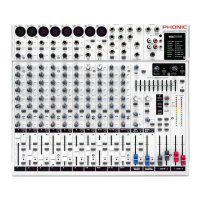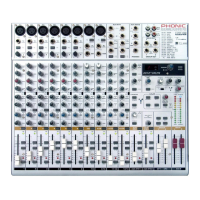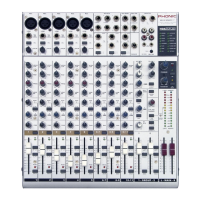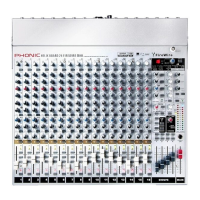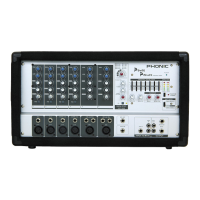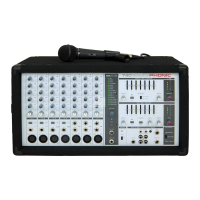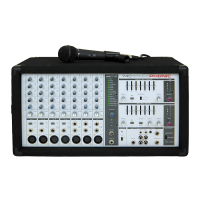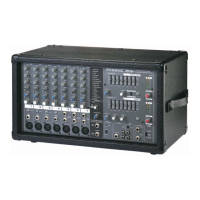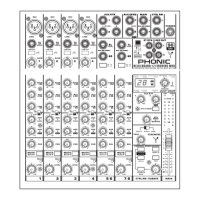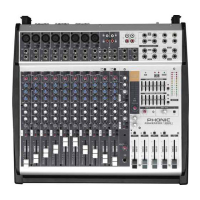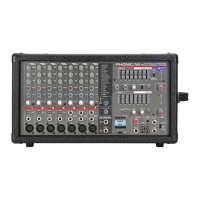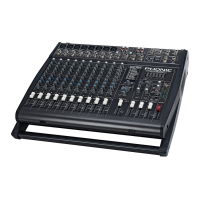Do you have a question about the Phonic Helix Board 18 Universal and is the answer not in the manual?
Essential safety guidelines and warnings for operating the audio mixer, covering electrical, environmental, and usage precautions.
Introduction to the Phonic Helix Board 18 Universal mixer, highlighting its features and market position.
Detailed list of the Helix Board 18 Universal's technical specifications and functionalities.
List of items provided in the Helix Board 18 Universal packaging.
Step-by-step guide for the initial setup, connection, and power-on sequence of the mixer.
Procedure for setting input levels and configuring individual channels for optimal audio performance.
Description of all input and output connectors, including Mic, Line, Stereo, Aux, Phones, Record, and 2T Return.
Details on Main L/R, Group 1/2, and Main XLR outputs for connecting to external audio systems.
Information on Control Room outputs, Foot Switch jacks, and Channel Insert points for monitoring and processing.
Description of the rear panel switches for main power and +48V phantom power.
Controls for Low Cut Filter, Line/Mic Gain, and Frequency EQ adjustments on channels.
Controls for channel ON, routing, Solo, Peak indication, and channel fader.
Details on the digital effect display, program selection, bypass, and send controls.
Controls for AUX Sends, EFX Send, and FireWire/USB trim adjustment.
Controls for Level Meter, Control Room source selection, level adjustment, and Pre/Post Solo.
Controls for 2T Return input, AUX Returns, and Group/Main faders for final output mixing.
Minimum computer specs and guide for installing drivers for FireWire/USB connection.
Detailed procedure for installing the Phonic FireWire/USB driver on Windows XP/Vista.
Steps to configure the Helix Board 18 Universal within macOS Audio MIDI Setup for audio routing.
How to map mixer channels to computer input channel names in DAW software.
Introduction to Cubase LE 4 and its installation and basic configuration with the mixer.
Using the control panel for managing devices, channels, synchronization, and properties.
Viewing stream details and configuring sampling rates for digital audio transfer.
Configuring ASIO and WDM buffer depths to manage audio latency.
Detailed technical specifications for mixer inputs, outputs, and master section features.
Technical data on frequency response, crosstalk, and power supply characteristics.
Essential safety guidelines and warnings for operating the audio mixer, covering electrical, environmental, and usage precautions.
Introduction to the Phonic Helix Board 18 Universal mixer, highlighting its features and market position.
Detailed list of the Helix Board 18 Universal's technical specifications and functionalities.
List of items provided in the Helix Board 18 Universal packaging.
Step-by-step guide for the initial setup, connection, and power-on sequence of the mixer.
Procedure for setting input levels and configuring individual channels for optimal audio performance.
Description of all input and output connectors, including Mic, Line, Stereo, Aux, Phones, Record, and 2T Return.
Details on Main L/R, Group 1/2, and Main XLR outputs for connecting to external audio systems.
Information on Control Room outputs, Foot Switch jacks, and Channel Insert points for monitoring and processing.
Description of the rear panel switches for main power and +48V phantom power.
Controls for Low Cut Filter, Line/Mic Gain, and Frequency EQ adjustments on channels.
Controls for channel ON, routing, Solo, Peak indication, and channel fader.
Details on the digital effect display, program selection, bypass, and send controls.
Controls for AUX Sends, EFX Send, and FireWire/USB trim adjustment.
Controls for Level Meter, Control Room source selection, level adjustment, and Pre/Post Solo.
Controls for 2T Return input, AUX Returns, and Group/Main faders for final output mixing.
Minimum computer specs and guide for installing drivers for FireWire/USB connection.
Detailed procedure for installing the Phonic FireWire/USB driver on Windows XP/Vista.
Steps to configure the Helix Board 18 Universal within macOS Audio MIDI Setup for audio routing.
How to map mixer channels to computer input channel names in DAW software.
Introduction to Cubase LE 4 and its installation and basic configuration with the mixer.
Using the control panel for managing devices, channels, synchronization, and properties.
Viewing stream details and configuring sampling rates for digital audio transfer.
Configuring ASIO and WDM buffer depths to manage audio latency.
Detailed technical specifications for mixer inputs, outputs, and master section features.
Technical data on frequency response, crosstalk, and power supply characteristics.
| Channels | 18 |
|---|---|
| Microphone Inputs | 8 |
| Stereo Inputs | 2 |
| Aux Returns | 2 |
| Phantom Power | Yes |
| USB Interface | Yes |
| Headphone Output | 1 |
| Type | Analog |
| Main Outputs | 2 |
| Monitor Outputs | 2 |
| EQ per Channel | 3-band |
